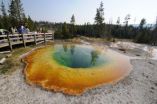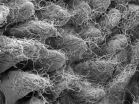(Press-News.org) SAN FRANCISCO, Sept. 17, 2014 – Patients with a recurrence of head and neck cancer who have previously received radiation treatment can be treated more quickly, safely and with fewer side effects with high doses of targeted radiation known as Stereotactic Body Radiation Therapy (SBRT) in combination with a drug that also carefully targets cancerous tumors. These findings from a UPMC CancerCenter study were presented today at the American Society of Radiation Oncology (ASTRO) annual meeting in San Francisco.
SBRT uses concentrated radiation beams in high doses to destroy tumors in difficult or hard-to-reach areas. The treatment is noninvasive, which minimizes damage to surrounding healthy tissue and organs. Clinicians at UPMC CancerCenter, partner with the University of Pittsburgh Cancer Institute (UPCI), used SBRT in combination with the drug cetuximab for patients who had a recurrence of squamous cell carcinoma of the head and neck after going through radiation.
"The prognosis for patients who have a recurrence of head and neck cancer that cannot be surgically removed is already poor. Traditional treatments can be associated with significant side effects so severe that patients give up on the therapy altogether," said Dwight E. Heron, M.D., vice chairman of radiation oncology at UPCI and director of Radiation Oncology Services at UPMC CancerCenter. "By taking these patients through an abbreviated course of targeted drug and SBRT, we minimize the side effects of treatment."
Doctors treated 48 patients with the combination therapy between July 2007 and March 2013. All of the patients were able to complete the treatments, which were administered in a span of about two weeks compared to traditional therapies which can take up to nine weeks. Severe toxicity was reported at 12 percent using the combination therapy, compared to upwards of 85 percent using conventional therapies.
"The good news here is that we improved their quality of life and did it safely," said John Vargo, M.D., a radiation oncology resident at UPMC CancerCenter and one of the lead authors of the study. "Unfortunately, outcomes using this approach are still challenging so the next part of our research will concentrate on continuing to find ways to improve outcomes by integrating additional novel systemic agents."
INFORMATION:
Collaborators on the study were Robert L. Ferris, M.D., Ph.D., James Ohr, D.O., David A. Clump, M.D., Ph.D., Kara S. Davis, M.D., Umamaheswar Duvvuri, M.D., Ph.D., Seungwon Kim, M.D., Jonas T. Johnson, M.D., Julie E. Bauman, M.D., M.P.H., Michael K. Gibson, M.D., and Barton F. Branstetter, M.D., all from UPCI or UPMC CancerCenter.
About UPMC CancerCenter
UPMC CancerCenter connects patients to the integrated expertise of leading clinicians, academic researchers, specialty programs and treatment centers. By partnering with the University of Pittsburgh Cancer Institute (UPCI), designated as a Comprehensive Cancer Center by the National Cancer Institute, we are accelerating the breakthroughs in our labs into clinical practice around the world. Backed by the collective strengths of UPMC and UPCI, UPMC CancerCenter is revolutionizing cancer research, care and prevention – one patient at a time.
Targeted radiation, drug therapy combo less toxic for recurrent head, neck cancers
2014-09-17
ELSE PRESS RELEASES FROM THIS DATE:
Nature's designs inspire research into new light-based technologies
2014-09-17
BELLINGHAM, Washington, USA -- "Nature has developed, very cleverly, some lessons on how to create the features that we desire in optical design," said Joseph Shaw, director of the Optical Technology Center at Montana State University. "As we explore surfaces and structures at the nanoscale, we'll discover them."
Some of those lessons were presented in San Diego in August during a conference called "The Nature of Light: Light in Nature" chaired by Shaw and Rongguang Liang of the University of Arizona College of Optical Sciences. The conference was part of SPIE Optics ...
In Joslin trial, Asian Americans lower insulin resistance on traditional diet
2014-09-17
BOSTON – September 17, 2014 – Why are Asian Americans at higher risk of developing type 2 diabetes than Caucasian Americans, and prone to develop the disease at lower body weights? One part of this puzzle may lie in the transition from traditional high-fiber, low-fat Asian diets to current westernized diets, which may pose extra risks for those of Asian heritage, says George King, M.D., Senior Vice President and Chief Scientific Officer at Joslin Diabetes Center and the senior author of the study.
A Joslin randomized clinical trial now has demonstrated that both Asian ...
Fighting parents hurt children's ability to recognize and regulate emotions
2014-09-17
Exposure to verbal and physical aggression between parents may hurt a child's ability to identify and control emotions, according to a longitudinal study led by NYU's Steinhardt School of Culture, Education, and Human Development.
The findings, which appear in the journal Development and Psychopathology, also suggest that household chaos and prolonged periods of poverty during early childhood may take a substantial toll on the emotional adjustment of young children.
"Our study points to ways in which aggression between parents may powerfully shape children's emotional ...
Persian Gulf states have new role to play in Israeli-Palestinian conflict resolution
2014-09-17
HOUSTON – (Sept. 17, 2014) – The shifting regional geopolitics of the Middle East have created new opportunities for the Persian Gulf states to engage in Arab-Israeli conflict resolution, according to a new paper from Rice University's Baker Institute for Public Policy.
"The Gulf States and Israeli-Palestinian Conflict Resolution," authored by Kristian Coates Ulrichsen, proposes a set of policy recommendations on how the Gulf states can engage with regional and international partners to create new pathways for action and cooperation. Ulrichsen is the fellow for the Middle ...
Why bioethics literacy matters
2014-09-17
From accessible and affordable health care to reproductive technologies, the justice and well-being of our society depend on the ability of people to identify key issues, articulate their values and concerns, deliberate openly and respectfully, and find the most defensible ways forward. But what are the best educational practices to support these societal conversations?
The Hastings Center and the Presidential Commission for the Study of Bioethical Issues have teamed up to publish a series of essays to highlight the best practices in teaching bioethics and to identify ...
Smallest known galaxy with a supermassive black hole
2014-09-17
SALT LAKE CITY, Sept. 17, 2014 – A University of Utah astronomer and his colleagues discovered that an ultracompact dwarf galaxy harbors a supermassive black hole – the smallest galaxy known to contain such a massive light-sucking object. The finding suggests huge black holes may be more common than previously believed.
"It is the smallest and lightest object that we know of that has a supermassive black hole," says Anil Seth, lead author of an international study of the dwarf galaxy published in Thursday's issue of the journal Nature. "It's also one of the most black ...
Gut bacteria, artificial sweeteners and glucose intolerance
2014-09-17
Artificial sweeteners, promoted as aids to weight loss and diabetes prevention, could actually hasten the development of glucose intolerance and metabolic disease; and they do it in a surprising way: by changing the composition and function of the gut microbiota – the substantial population of bacteria residing in our intestines. These findings, the results of experiments in mice and humans, were published today in Nature. Among other things, says Dr. Eran Elinav of the Weizmann Institute's Immunology Department, who led this research together with Prof. Eran Segal of Computer ...
New branch added to European family tree
2014-09-17
The setting: Europe, about 7,500 years ago.
Agriculture was sweeping in from the Near East, bringing early farmers into contact with hunter-gatherers who had already been living in Europe for tens of thousands of years.
Genetic and archaeological research in the last 10 years has revealed that almost all present-day Europeans descend from the mixing of these two ancient populations. But it turns out that's not the full story.
Researchers at Harvard Medical School and the University of Tübingen in Germany have now documented a genetic contribution from a third ancestor: ...
Natural born killers: Chimpanzee violence is an evolutionary strategy
2014-09-17
ANN ARBOR—Man's nearest relatives kill each other in order to eliminate rivals and gain better access to territory, mates, food or other resources—not because human activities have made them more aggressive.
That is the conclusion of an international analysis of lethal aggression among different groups of chimpanzees in Africa studied over five decades. The research appears in the current issue of Nature.
"Observations that chimpanzees kill members of their own species have influenced efforts to understand the evolution of human violence," said University of Michigan ...
What set the Earth's plates in motion?
2014-09-17
The mystery of what kick-started the motion of our earth's massive tectonic plates across its surface has been explained by researchers at the University of Sydney.
"Earth is the only planet in our solar system where the process of plate tectonics occurs," said Professor Patrice Rey, from the University of Sydney's School of Geosciences.
"The geological record suggests that until three billion years ago the earth's crust was immobile so what sparked this unique phenomenon has fascinated geoscientists for decades. We suggest it was triggered by the spreading of early ...




